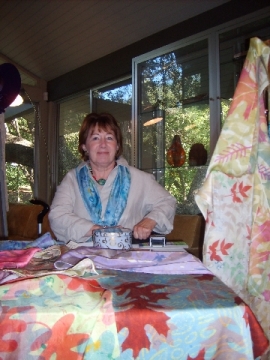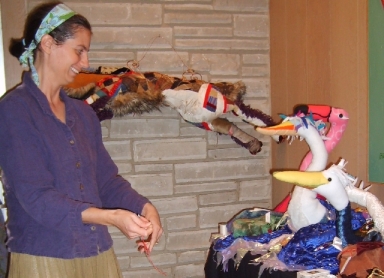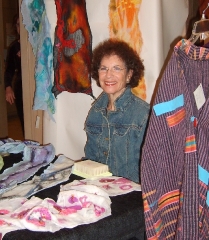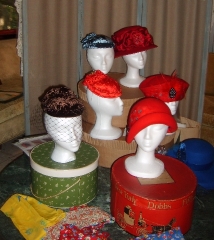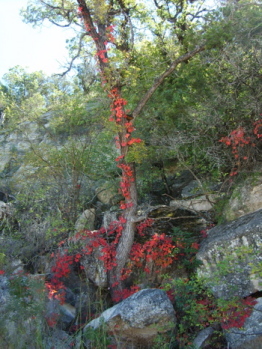Teaching a class with this title at the Southwest School of Art and Craft, I challenged myself to come up with 100 ways that one could “make a mark” on fabric. This list is by no means complete – and we certainly didn’t make it through all the techniques in the one 8-session course of study, but I also figure that most of the methods can be used with three different media -- acrylic textile paints, dye and discharge chemicals, so many of the techniques listed are three-in-one. I made the list to serve me (and those artists who take my courses) as a reminder – a tickler – a spur to experiment and stretch. We all get dependent on a few tricks and forget that a whole bag is waiting to be investigated.
I certainly don’t claim ownership of any of the methods or techniques here listed. You’ll find many of them in any good surface design book – I give credit to Jane Dunnewold (Complex Cloth)and her ArtCloth Studios courses for most of my own technical experimentation and any mastery that I may have developed to her encouragement.
Many of these printing/mark-making techniques can be used with textile inks (screen-printing type –thick or medium density, such as Setacolor, or thin, like DekaSilk), with dye thickened with sodium alginate or commercial dye thickener, with dishwashing gel containing bleach for discharge, or one of the commercial discharge pastes.
Most supplies (dyes, paints, chemicals, thickeners) can be purchased at Dharma Trading Company. Dyes and chemicals are also available from Pro Chem.
Procion MX dyes are to be used on natural fibers only and need batching (sitting damp in a warm place) generally in order for the chemical reaction to take place. Most textile paints MUST be set by ironing after dry or other heat-set method. Do not iron until dry in order to avoid toxic fumes.
PLEASE follow safety techniques including gloves, dust masks and respirators as needed. This list is intended as a tickler list for surface design artists – not as a manual of detailed instructions. Consult technical manuals for dye recipes, specific techniques and how-tos. But if something really intrigues you, add a comment and I’ll try to give more specific instructions.
STAMPING
1. Erasers (art gum or white artist erasers) can be carved with relief shapes using Xacto knife
2. Eraser stamps can be carved, then ganged together by gluing to plastic or wood block (use E6000 glue or similar) to make a mosaic of patterns
3. Speedy Stamp blocks or other carvable material, carved with lino cut tools (material available from Dharma or Dick Blick or similar art supply site)
4. Styrofoam plates or meat trays “etched” with design using pen or sharp stylus
5. Styrofoam plates or meat trays cut into shapes and mounted on wooden blocks
6. “Fun foam” precut shapes (the stuff of summer camp projects) glued (or use self adhesive stamps) onto blocks – double-thick for best results
7. “Fun foam” cut into original designs and mounted on blocks or plastic corrugated board (double thick again, best for ink impressions)
8. Adhesive sheet craft felt cut into shapes and mounted on printing blocks (both poly felt and plastic textured “felt)
9. Compressed sponges cut into shape while dry, then wet with paint or dye to make sponge printing blocks
10. Natural or poly sponges torn or cut for rough texturing stamps or overall texturing
11. Foam rollers carved or impressed with string or rubber bands to make rollable texture stamps
12. Cut packing material into large shapes for printing or use “as is”
13. Print with found objects (kitchen utensils, plastic plates, bubble wrap etc)
14. Stamp with vegetables cut in flat sides or in shapes (ie potato prints)
15. Stamp with hands, feet, body parts
16. Make leaf prints by thinly rolling leaves with paint or dye on the vein side, burnish on fabric to print
17. Make printing plates with layers of corrugated paper cut in patterns and stacked and glued, Coat with polyurethane to make permanent.
18. Use moldable foam stamp material to make heat-set designs (from Dharma)
19. Carve linoleum blocks to use for printing
20. Use “tjaps” from India or Indonesia for stamping paint or dye (wooden or metal)
21. Use modeling clay, play dough or polymer clay to make stamps – use either soft or hardened –make an imprint with a textured object or shape, brush on a textile paint or thickened dye
22. Commercial stamps from hobby and craft store – foam, rubber, wood, etc.
MONOPRINTING
23. Spread or brush paint or dye on large plastic plate or plastic drop cloth. Monoprint with fabric yardage
24. Brush paint in designs on textured surfaces such as bubble wrap, textured grids for ceiling lights, etc.
25. Adhere freezer paper in torn or cut designs by ironing to fabric, Brush, spray or roll on paint, dye or discharge
26. Cut large shapes from corrugated paper (single corrugated that has ridges on outside of sheet) Use to monoprint
27. Spread paints or thickened dye on a textured plastic surface
28. Brush dye or paint on plastic lace tablecloths, lay fabric on top of it and press to monoprint
STENCILING
29. Cut stencils with freezer paper and adhere to fabric by ironing
30. Cut stencil design from magazine art, using the picture as your guide, coat with layer of clear packing tape on both sides to strengthen
31. Use commercial stencils and parts of stencils overlapping with one another to add interest, cut up commercial stencils and recombine with clear tape
32. Cut your own stencils from poster board or old file folders. Coat with clear plastic spray to make more durable
33. Use found objects – plastic lace, grids, wire mesh, etc – as stencils
34. Use spray paint -- water- or enamel-based -- with stencils
35. Use spray misting bottle filled with dye for stenciling
36. Use spray misting bottle filled with bleach for resist stenciling (USE A RESPIRATOR AND PROTECTIVE CLOTHING , WORK OUTDOORS – bleach in the air is very dangerous to your lungs)
MARK-MAKING/DRAWING
(These methods use the drawing instrument, not dye or paint unless noted)
37. Paint or draw with thin and/or thickened dye on damp or dry fabric
38. Paint or draw with silk paints or thinned fabric paints on damp or dry fabric
39. Use salt on thin washes to develop textures
40. Draw with fabric markers (iron to set)
41. Draw with permanent markers such as sharpies (iron to set)
42. Draw with crayons (iron to set)
43. Draw with transfer fabric crayons on paper – iron onto fabric to transfer (ON poly fibers only)
44. Draw with oil pastels, iron to set
45. Use crayons, oil pastels or crayons with stencils or as rubbings over textured objects or plates
46. Use water soluble crayons (caran d’ache) on a silk screen, and then screen with polymer medium
47. Stretch fabric on frame and paint with gutta and silk paints (see Dharma catalog for instructions)
48. Draw directly on fabric with India Ink
49. Use Setacolors to make “sun prints” (see manufacturers instructions)
50. Crumple or fold fabric and apply dye with spray misting bottle, leaving patterns through creasing and wrinkling.
TRANSFERS AND FOILS. PHOTOTRANSFER
51. Transfer illustrations or text to fabric using polymer medium – apply wet in patterns, burnish papers to wet medium, let dry and wash away the paper leaving ink
52. Apply polymer medium with stamps, stencils etc to fabric. Let dry, iron on foil (shiny side up)
53. Cut shapes from WonderUnder or other fusible webbing and iron on, remove paper, iron on foil
54. Print image or design on BACK of foil, let dry, iron on to fabric
55. Use commercial transfer paper with an inkjet printer, iron to transfer
56. Print directly on fabric – commercial product or sheets you make by ironing smooth fabrics to freezer paper, fuse or stitch to larger fabrics
RESISTS
57. Use washable school glue to paint on a resist before dyeing
58. Use commercial resist (PRESIST) to paint on before dyeing
59. Fold, clamp, rubber band your fabric to make a physical resist
60. Stamp, stencil etc with polymer gel medium. Let dry thoroughly then dye or dye paint. Dried polymer gel medium acts as a resist.
61. Use flour paste to block areas of fabric
62. Use rice paste to block areas of fabric
63. Use hot wax (traditional batik method or soy wax) – stamped, painted, etc.
64. Stitch patterns on fabric, pull to gather tightly, then dye or spray with thinned paint, stitching forms the resist
THERMOFAX and SCREENPRINTING
65. Use natural objects to make a screen by photocopying it (leaves, sticks, etc)
66. Use manmade objects such as lace, fabric with thick texture, etc to make a thermal screen
67. Draw a picture and photocopy it to make a thermal screen
68. Make a collage for a thermal screen
69. Make a stencil on the back of a screen by ironing (carefully) on freezer paper
70. Cut a screen stencil from contact paper
71. Use hot wax or soy wax to make a screen stencil
72. Stamp some of your favorite stamps in patterns to make a thermal screen
73. Using the same design, enlarge, reduce and make multiples to design different screens –make a family of related thermal screens or traditional screens
74. Use drawing fluid to draw a design, then coat with red screen filler, wash out drawing fluid to leave your design as a stenciled screen
75. Apply a thin layer of flour paste to a screen. Let dry and etch a design
76. Make a photo-emulsion screen (instructions in books and on the web)
EMBELLISHMENTS
77. Add beads in patterns or randomly
78. Stitch by hand or machine – fancy or plain embroidery stitches (This could be 100 ways all on its own!)
79. Piece torn strips of fabric, seam out
80. Piece cut fabric squares or other shapes
81. Appliqué fabric shapes and designs
82. Sew on found objects, such as keys, chains, paper clips etc
83. Using fusible webbing, adhere photos, paper, fabric, textures, leaves, plant material etc
84. Collage using polymer medium and layers of fabric, texture, etc
85. Coat fabric with layers of beeswax to make a fabric encaustic
86. Stiffen fabric with starch or polymer medium
87. Iron on interfacing to stiffen
88. Fold or crumple polyester fabrics and drop in boiling water to make creases permanent
89. Use safety pins, studs, snaps or buttons as decorative embellishments
90. Use zippers as embellishments
OTHER
91. Rust fabric by layering it with iron objects, spray with 50/50 vinegar solution, leave wrapped in plastic in the sun for several days
92. Rip, tear or otherwise distress fabric
93. Burn edges or areas of fabric (BE CAREFUL)
94. Compost fabric by burying it for several weeks in soil or organic material
95. Coat fabric with colored clays or mud to stain it (Mud cloth techniques)
96. Tear or cut fabric in strips and weave it back together.
97. Tear or cut fabric in strips and braid it, knot it or twist it into shapes.
98. Quilt by hand or machine, layering fabric and batting, traditional or experimental.
99. Fray the edges of fabric, fringing all the sides or just the ends.
100. Pull threads to make patterns in your fabric.
 Saturday, November 18, 2006 at 07:33AM
Saturday, November 18, 2006 at 07:33AM 



